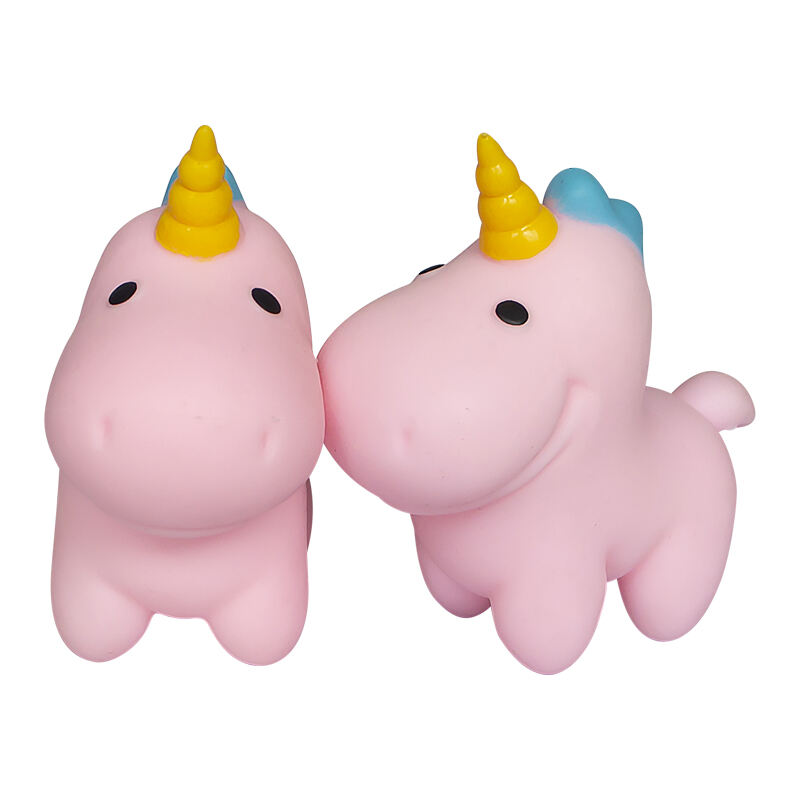Understanding Anxiety in Students and the Role of Fidget Toys
Why Students Are Turning to Anxiety Relief Fidget Toys
Around 40 percent of students deal with anxiety issues these days, so coming up with good ways to cope matters a lot. Fidget toys have gained popularity as something that really helps, especially those designed specifically for anxiety relief. Take mochi squishy toys for instance they work wonders because they let kids channel all that restless energy somewhere productive instead of letting it build up inside. Teachers report seeing students focus much better during class when they can play with these sensory tools between assignments. Pretty much everyone who tries them finds some benefit, whether it's just having something to do with their hands while listening to lectures or using the tactile feedback to calm down before tests.
The Science Behind Sensory Toys and Stress Reduction
Studies show sensory stimulation actually cuts down on stress by reducing cortisol, the body's main stress hormone (as reported in the Journal of Neuroscience back in 2016). These kinds of sensory toys work on touch receptors, which creates a soothing reaction helping kids manage their emotions better. Psychologists have noticed something interesting too. When students are dealing with tough school situations, playing with tactile toys doesn't just calm them down but might actually boost thinking skills during those intense test periods or project deadlines.
Balancing Focus and Fidgeting in Academic Environments
Finding the right balance between fidget toys and classroom attention matters a lot for creating good learning conditions. Many teachers find ways to let kids use these toys mindfully so they stay focused but don't bother classmates. Schools need to watch what happens when these items enter classrooms, both for individuals and groups working together. When brought into class carefully, fidget toys actually help some students manage stress better without messing up lessons for everyone else. Some schools report fewer disruptions after implementing rules around toy usage during study time.
Top Fidget Toy Types for Anxiety Relief
Mochi Squishy Toys: Soft and Malleable Stress Relievers
Mochi squishy toys feel amazing when touched, their soft squishy texture just right for unwinding after a tough day. Crafted from those stretchy materials that give way under pressure, these little guys help students relax while hitting books hard in class or at home. The best part? They look cute enough to keep on a desk without anyone noticing what's happening beneath the surface. Students can squeeze away tension during lectures or between classes without anyone giving them funny looks. Want to see if one might work for managing stress levels? Take a peek at what people are saying about actual Mochi Squishy Toys online.

Stress Balls for Adults: Compact and Classroom-Friendly
Stress balls designed for adults provide a pretty good method for working off some tension just by squeezing them around. The colorful designs and small size mean these little gadgets actually work wonders for keeping students' minds on track during boring classes. Some studies point out that people who regularly play with stress balls tend to get stuff done faster while feeling less swamped by everything going on. Since they don't draw attention when used, classrooms become ideal places to keep one handy whenever focus starts slipping away. Anyone curious about how stress balls might help manage anxiety could look into different options available on the market today.

Tactile Fidget Spinners: Quiet Tools for Concentration
Fidget spinners give kids something physical to focus on when they're feeling restless, helping direct all that extra energy into something useful instead of bouncing off walls. The way they're built keeps them pretty quiet, so they work well even in places where talking is not allowed, like during tests or reading time at school. A few recent research papers have actually shown these little toys can help create better classroom atmospheres because students tend to concentrate more when they have something to fiddle with. Most teachers notice that kids using fidget spinners seem to stay engaged longer without bothering classmates around them. For anyone wondering how these simple gadgets might help with stress and anxiety, there's plenty of evidence pointing toward real benefits beyond just entertainment value.

Sensory Putty and Squeeze Toys with Shape
Sensory putty gives people a creative outlet and works great for reducing stress too. These squeeze toys come in all sorts of shapes and textures that appeal to different senses, which makes playing with them feel really good on the hands. When kids or adults play with this stuff regularly, it helps build those small muscle movements in the fingers and hands while calming down anxious feelings at the same time. Teachers often find these putties useful in classrooms where students need something to focus on when they're feeling overwhelmed. Many parents report seeing real improvements in their children's ability to handle stressful situations after regular play sessions with sensory materials.

Benefits of Stress Relief Toys in Academic Settings
Improving Focus During Lectures and Study Sessions
Stress relief toys work pretty well for keeping attention during long lectures or when hitting the books for hours straight. These little gadgets give restless fingers something to do while still letting people stay focused on what they need to learn. Teachers have noticed something interesting too. When kids bring their fidget toys to class, there seems to be fewer distractions overall, which makes the whole classroom vibe better for everyone involved. One recent experiment looked at college students using these toys during study periods. The ones who played with them remembered more info later on, so it looks like these simple devices might actually help boost grades without anyone really noticing.
Reducing Test Anxiety and Social Stress
Fidget toys seem to be making a real difference when it comes to helping students deal with test anxiety and social stress in school settings. A lot of kids find that having something tactile to play with, like those soft mochi squishy toys, keeps them grounded during stressful moments such as exams. Several students have actually talked about how these little gadgets give them confidence boosts and make hanging out with others less intimidating because they can channel nervous energy into squeezing or twisting something instead. When anxiety levels drop, grades tend to go up too, which is why many teachers now keep boxes of fidget items around classrooms. Schools across the country are starting to recognize that these simple stress busters might just be worth their weight in gold for improving overall student performance.
How to Choose the Right Fidget Toy for Your Needs
Prioritizing Noise Level and Discreet Design
Picking out fidget toys? Go for the quiet ones if possible, especially when trying to keep things peaceful in school settings. Toys that make noise can really throw off both classmates and instructors during lessons. Some studies have actually shown kids tend to do better on tests when their fidgets aren't making all sorts of racket around them. Soft stress balls work great, as do those squishy mochi toys that bend but don't squeak or click. Teachers often appreciate these silent options because nobody gets distracted by random sounds coming from desk corners during important discussions.
Matching Sensory Preferences (Texture, Resistance, Motion)
Getting to know how different people respond to various sensations makes all the difference when picking out good fidget toys. Textures feel different on skin, some materials offer more give than others, and movement patterns just click better with certain folks. Most experts agree that trying several kinds helps figure out what actually works for each person. Take kids in classrooms for example many teachers notice that children who test out different options tend to settle on something they really connect with. Some gravitate toward squishy silicone pieces that melt under fingers, whereas others get hooked on those firm grip balls that require actual effort to squeeze repeatedly until tension fades away naturally.
Durability and Portability for Busy Student Lifestyles
When picking out fidget toys for kids at school, durability matters a lot since these little gadgets get put through the wringer day after day in active classrooms. They also need to be small enough so students don't struggle carrying them from one class to another. A recent study found that when kids can actually take their fidget toys anywhere, they tend to find them much more helpful for dealing with nervous feelings during tests or transitions between subjects. Stress balls and other compact sensory toys that slip right into backpack pockets work wonders for students who deal with anxiety as they bounce between activities all day long.
Incorporating Fidget Toys into Daily Student Life
Using Stress Ball Toys During Breaks and Transitions
Adding stress balls to those short study breaks really helps students get back on track. When kids squeeze these little rubbery things in their hands, it actually cuts down on tension and gets their brains ready to pay attention again. Schools have noticed this works especially well when moving from one class to another. Students often grab a stress ball right before switching subjects so they can shake off whatever worries were building up. Some teachers even keep boxes of them at the front of the room for quick access. The simple act of squeezing something soft seems to reset their mental state, making it easier to dive into whatever comes next without carrying over all that classroom stress.
Establishing Boundaries to Avoid Distractions
Getting the most out of fidget toys in classrooms really depends on setting some basic rules about when and how they can be used. Students who understand exactly what's allowed tend to stay focused better during lessons since they aren't constantly playing with them all day long. Teachers should also make sure kids only use these toys at certain times so nobody gets distracted by someone else's movements across the room. Most schools have policies that talk about using fidget items responsibly, not as toys for constant entertainment. What works best seems to vary between different classrooms, but generally speaking, keeping their use limited appears to help students concentrate more effectively without disrupting others around them.

